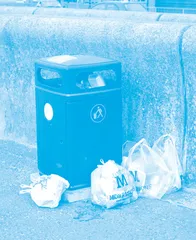The Importance of Sustainable Consumption in a Changing Climate气候变化时代可持续消费的重要性
作者: 多拉·马里马 修文乔译

We live in a fast-paced world where things change rapidly, goods are designed to become obsolete so that they will be replaced sooner, thus putting more pressure on resources like energy, water, land and the natural envir-onment. This is at the heart of global warming. Climate change is a symptom of a deeper modern-day problem of overconsumption which demands more mining of natural resources, manufacturing of goods and greater offerings of services to the modern society we live in. The sectors that contribute mostly to greenhouse gas emissions include transport, energy, industrial production, services, construction and agriculture. At the heart of these highly polluting and climate unfriendly sectors lie human beings who demand cars, airplanes, electricity, large offices and homes, telecommunication services, technologies, entertainment, fast food and so on. These consumption-related carbon emissions are fueled by a growing consumerism culture. However, carbon emissions are seen as produced by industries without recognizing the role that people make in driving production through consumer patterns. This also results in a missed opportunity to challenge consumers to demand sustainably produced goods and services that will require industries to relook at their production processes and make them less carbon-intensive.
我们生活在一个高速运转的世界,万物瞬息变化。商品使用周期设计得很短,因而可以很快更替。这一切给能源、水、土地和自然环境等资源带来了更大的压力,而这正是全球变暖的关键所在。气候变化是现代深层次问题“过度消费”的症状之一,而“过度消费”要求我们开采更多的自然资源,生产更多的产品,为我们所生活的现代社会提供更多的服务。排放温室气体最多的行业包括交通运输、能源、工业生产、服务、建筑和农业。这些污染程度高、对气候不友好的行业都是为人类服务的。人类对汽车、飞机、电力、大型办公室和住宅、电信服务、技术、娱乐和快餐等有需求。这些与消费相关的碳排放的背后推手是日益盛行的消费主义风气。然而,人们认为碳排放由各行业所致,却没有意识到自己通过消费模式助推了生产活动。如此还会错失机会去激励消费者产生对可持续商品和服务的需求,而要提供这类商品和服务,各行业必须重新审视自己的生产流程,降低碳排放。
What fuels overconsumption?
是什么助长了过度消费?
Throw-away mentality
“用完即弃”心态
This modern society is character-ized by overconsumption and excessive production resulting in a flood of convenient, disposable, throw-away products made out of plastic that release greenhouse gases and toxins, both dur-ing production and when disposed-off. This throw-away society no longer sees value in durable, repairable products that could last forever but prefer to buy mass produced, cheap products that are discarded with little regard for where they end up.
现代社会的特点是过度消费和过度生产,结果产生了大量便于使用的一次性塑料制品。这些塑料制品在生产过程中和废弃处理时都会释放温室气体和毒素。这个崇尚“用完即弃”的社会不再看重可以永久使用的、既耐用又可修的产品,而更喜欢购买大批量生产的廉价产品。丢弃这类产品后,人们几乎不关心它们的最终去向。
“Microwave” culture
“微波炉”文化
Overconsumption is driven by the need to “want and get everything right now”! Consumers don’t want to wait for anything in these modern days. This has been exacerbated by a flood of technologies like microwaves, machine machines, hair dryers, toasters, cellular phones, computers and so on that make society believe that everything must be readily available at their fingertips. Even though technology has increased efficiency and production practices have improved, many of these products are made out of disposable material that is not easily repaired, resulting in heaps of plastic and electronic-waste filling up landfills and toxins leaching into the soil.
“过度消费”是由“想要就能马上得到”的需求驱动的!在现代社会,消费者不想等待任何东西。微波炉、机械设备、吹风机、烤面包机、手机、电脑等技术的涌现更加剧了这一趋势,它们让大家认为一切都应唾手可得。虽然技术提高了生产效率,改进了生产方法,但很多产品是由不易修复的一次性材料制成的,导致大量的塑料和电子废弃物堆积在垃圾填埋场里,毒素渗入土壤。
Why is sustainable consumption key to fighting climate change?
为何可持续消费是应对气候变化的关键?
The United Nations Environment defines sustainable consumption as the use of material products, energy and immaterial services in such a way that it minimizes the impact on the environment, so that human needs can be met not only in the present but also for future gener-ations. This is crucial in order for sustainable development to be achieved and as a result, the United Nations has Goal Number 12 that deals with sustainable consumption and production. This goal requires consumers to rethink their individual consumption patterns and assess the environmental impact of everything that they are consuming. Consumers should be making consumption choices based on how much water, energy, land and raw materials the products and services they are acquiring have used. This will mean, for instance, deciding to eat less processed food and red meat, driving and flying less, buying less clothes, toys, gadgets and other unnecessary goods and services.
根据联合国环境规划署的定义,可持续消费指人类使用物质产品、能源和非物质服务时,将对环境的影响降到最低,从而既能满足当前的需要,又能满足后代的需求。这对于实现可持续发展至关重要,因此,联合国制定了针对可持续消费和生产的“第12项目标”。这一目标要求消费者重新审视个人消费模式,并评估他们所消费的一切对环境有何影响。消费者应根据所购买的产品和服务使用了多少水、能源、土地和原材料进行消费选择。举例来说,这将意味着决定少吃加工食品和红肉,少开车,少坐飞机,少买衣服、玩具、小物件和其他非必要的商品和服务。
What is required for sustainable consumption to be achieved?
如何实现可持续消费?
Transformational action
变革行动
Sustainable consumption requires transformational action on the part of the consumer that will result in a fundamental change in the way that goods and services are produced and consumed. Consumers cannot continue with the usual “not-in-my-backyard1” attitude where their waste is thrown into the bin to be disposed-off in a place far away from them and perhaps close to informal housing areas emitting a foul smell. It is incumbent upon society itself to look for new and transform-ative ways in which consumers think more carefully about the materials that are used to make products, where these products were made, how they were made, packaged, transported; how they are prepared, how they are consumed and disposed of. The life-cycle analysis of products is a very key issue.